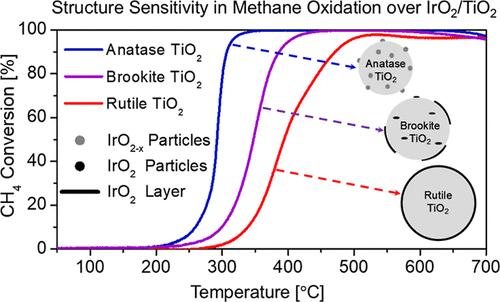二氧化钛负载IrO2催化剂在甲烷完全氧化中的结构敏感性
IF 13.1
1区 化学
Q1 CHEMISTRY, PHYSICAL
引用次数: 0
摘要
TiO2负载型催化剂在多种反应中表现出较高的催化性能,催化活性往往依赖于TiO2的结构。然而,关于TiO2结构如何影响活性金属或金属氧化物,从而影响催化性能的详细知识仍然缺乏。因此,合理设计tio2负载催化剂仍然是一个挑战。为了确定TiO2结构对iro2基甲烷氧化催化剂的影响,选择了锐钛矿、金红石和板岩TiO2三种TiO2相作为催化剂载体。不同的IrO2负载也被用来改变IrO2的粒径和调整IrO2 - TiO2的相互作用,并评估了三种不同粒径的锐钛矿TiO2。结果表明,IrO2-TiO2相互作用具有结构敏感性,其催化活性不仅与TiO2的结构有关,还与TiO2的粒径有关,铱的负载对反应的影响也与TiO2的结构有关。IrO2负载在锐钛矿TiO2上,平均粒径为10 nm,具有较高的催化活性和50 h的稳定性,是性能最好的催化剂。该催化剂由细小且分散良好的IrO2纳米颗粒在TiO2载体上组成。相反,金属-载体之间的强相互作用会在金红石和板绿石TiO2载体表面形成一层薄薄的IrO2膜。与锐钛矿TiO2载体上的IrO2相比,这些相互作用导致IrO2更难以还原。这在x射线光电子能谱(XPS)测量中得到进一步证明,该测量显示反应后锐钛矿TiO2载体上形成了还原性IrO2。这表明IrO2中的表面氧空位在反应中起着关键作用。该研究还表明,金红石TiO2负载的IrO2催化剂失活可能是由于活性IrO2位点的损失,而在板岩TiO2负载的IrO2上观察到的活性随时间的损失是由于板岩TiO2载体的降解。这些结果强调了支撑结构和颗粒尺寸在二氧化钛负载IrO2甲烷氧化催化剂中的重要性,这些效应也可能影响其他催化剂体系和反应,突出了它们在合理催化剂设计中的重要性。本文章由计算机程序翻译,如有差异,请以英文原文为准。

Structure Sensitivity of TiO2-Supported IrO2 Catalysts in the Complete Oxidation of Methane
TiO2-supported catalysts exhibit high catalytic performance in numerous reactions, and the catalytic activities are often dependent on the TiO2 structure. Yet, detailed knowledge of how the TiO2 structure affects active metals or metal oxides, and thus the catalytic performance, is still lacking. Therefore, rational catalyst design of TiO2-supported catalysts remains a challenge. To determine the effects of TiO2 structure on IrO2-based catalysts in the oxidation of methane, three TiO2 phases were selected, anatase, rutile, and brookite TiO2, and used as catalyst supports. Different loadings of IrO2 were also used to vary the IrO2 particle size and tune IrO2–TiO2 interactions, and three different particle sizes of anatase TiO2 were evaluated. The results reveal that the IrO2–TiO2 interactions are structure sensitive and the catalytic activity is not only dependent on the titania structure but also the TiO2 particle size and the influence of iridium loading on the reaction is dependent on the TiO2 structure. The best-performing catalyst is IrO2 supported on anatase TiO2 with an average particle size of 10 nm, due to its high catalytic activity and better stability during 50 h on stream. This catalyst consists of small and well-dispersed IrO2 nanoparticles on the TiO2 support. In contrast, strong metal–support interactions result in a thin IrO2 film on the surfaces of both the rutile and brookite TiO2 supports. These interactions result in IrO2 species that are more difficult to reduce compared with the IrO2 on the anatase TiO2 supports. This is further evidenced in the X-ray photoelectron spectroscopy (XPS) measurements, which reveal the formation of reduced IrO2 on the anatase TiO2 support after reaction. This indicates that surface oxygen vacancies in IrO2 play a critical role in the reaction. This study also reveals that catalyst deactivation over IrO2 supported on rutile TiO2 is likely due to loss in active IrO2 sites, while the observed loss in activity with time on stream over the IrO2 supported on brookite TiO2 is due to degradation of the brookite TiO2 support. These results underscore the importance of support structure and particle size in TiO2-supported IrO2 catalysts for methane oxidation, effects that are likely to influence also other catalyst systems and reactions, highlighting their importance in rational catalyst design.
求助全文
通过发布文献求助,成功后即可免费获取论文全文。
去求助
来源期刊

ACS Catalysis
CHEMISTRY, PHYSICAL-
CiteScore
20.80
自引率
6.20%
发文量
1253
审稿时长
1.5 months
期刊介绍:
ACS Catalysis is an esteemed journal that publishes original research in the fields of heterogeneous catalysis, molecular catalysis, and biocatalysis. It offers broad coverage across diverse areas such as life sciences, organometallics and synthesis, photochemistry and electrochemistry, drug discovery and synthesis, materials science, environmental protection, polymer discovery and synthesis, and energy and fuels.
The scope of the journal is to showcase innovative work in various aspects of catalysis. This includes new reactions and novel synthetic approaches utilizing known catalysts, the discovery or modification of new catalysts, elucidation of catalytic mechanisms through cutting-edge investigations, practical enhancements of existing processes, as well as conceptual advances in the field. Contributions to ACS Catalysis can encompass both experimental and theoretical research focused on catalytic molecules, macromolecules, and materials that exhibit catalytic turnover.
 求助内容:
求助内容: 应助结果提醒方式:
应助结果提醒方式:


